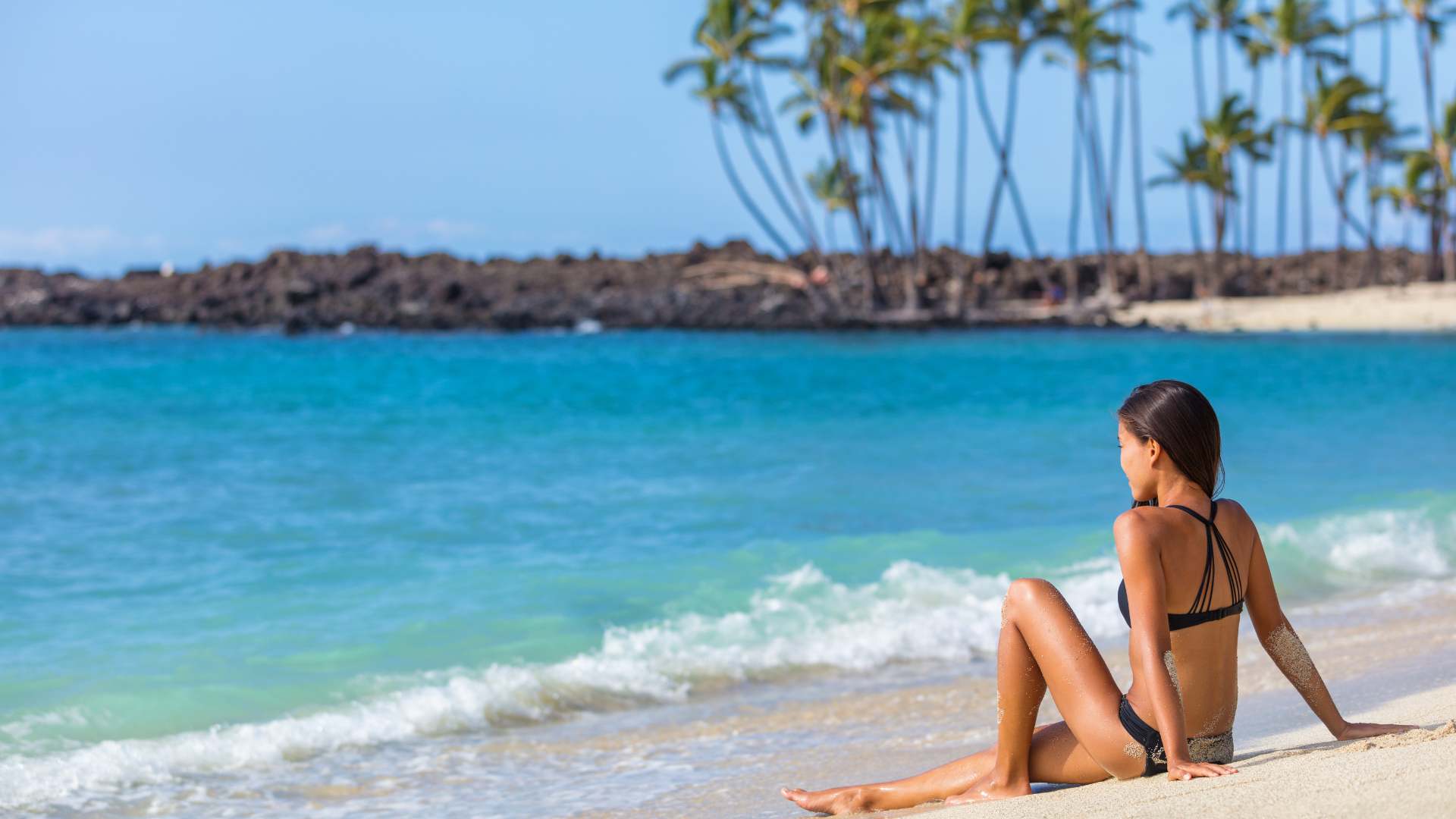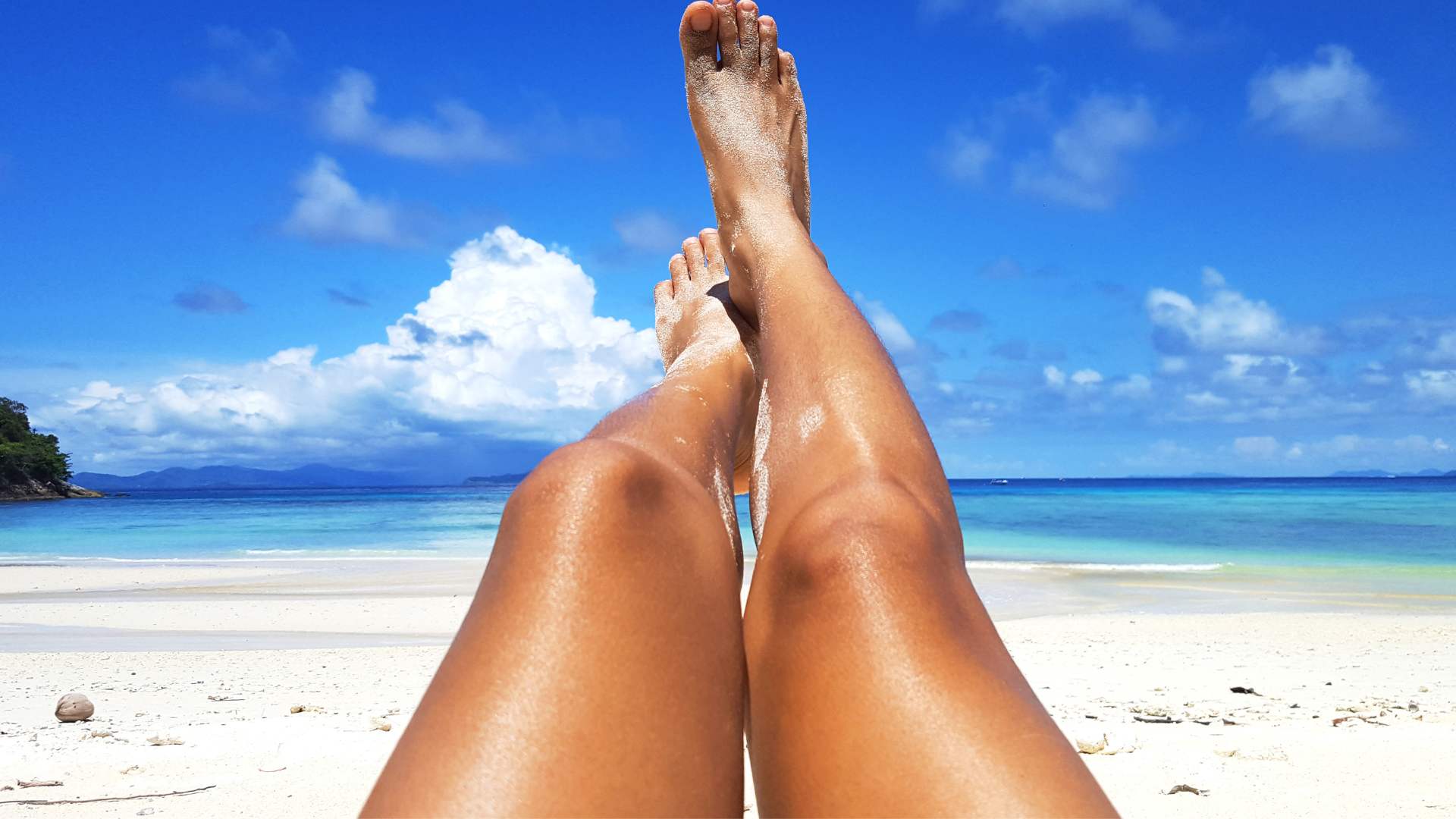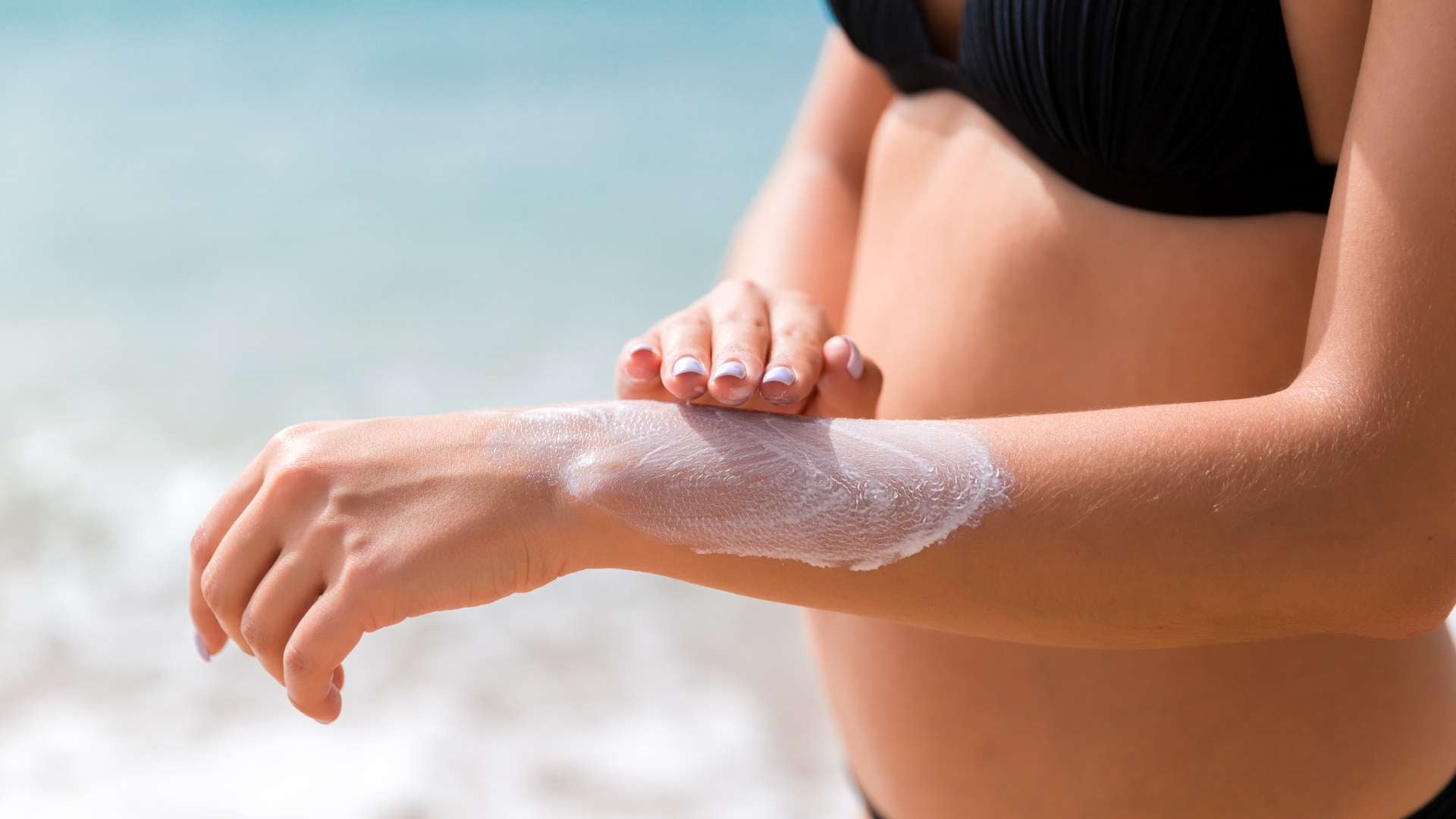
How long does it take to tan in UV 6?
UV 6 sun gives you a tan but puts you at risk for sunburn. Your skin will start to tan within 15 to 30 minutes under this medium-strong sunlight, depending on your skin type.
We'll share sun protection tips and explore how to keep your skin healthy while you bronze in UV 6 conditions.
Quick links:
Factors affecting tanning time
Before you head to the beach, get SwimZip’s UPF 50+ sun-protective swimwear. Our collection looks great and shields your skin against harmful UV rays.
What is the UV index?
The UV index is an easy way to gauge the potential for skin damage from the sun's rays. This 1–14+ rating is based on cloud cover, ozone levels, location, and time of year. Higher numbers indicate stronger UV radiation.
While all UV exposure carries some risk, the index guides sun protection needs:
- UV Index 1–2: minimal sun protection needed
- UV Index 3–5: moderate protection is advised
- UV Index 6–7: high risk of harm, cover up and use caution
- UV Index 8–14: dangerous, avoid extended exposure
Before planning your day, take a look at our UV index checker for smart sun protection.
What should you know about UV 6?
At UV 6, tanning happens quickly. Light-skinned individuals start to tan in as little as 15 minutes but also risk burning in under 20 minutes if unprotected. People with darker skin begin tanning in 20–30 minutes because of their natural melanin defenses, but still face risks after prolonged exposure.
Here's how different skin tones tan at UV 6:
- Fair skin: visible tanning in 15–20 minutes, high burn risk
- Medium skin: noticeable tan in 20–25 minutes
- Dark skin: subtle tanning in 25–35 minutes
Indoor tanning beds are not a safer option. They also emit UV radiation and a tanning bed set to UV 6 will still cause skin damage over time.
Which factors affect tanning in UV 6?
UV 6 sunlight causes rapid tanning but increases the risk of sunburn. Here are some factors that impact tanning in UV 6 sunlight:
- Skin type. Light skin tans slowly and burns easily, it might take only 15–20 minutes to turn red. Dark skin tans faster because of higher melanin content. Darker complexions may show color changes within 30 minutes of UV 6 exposure.
- Time of day. The UV index commonly reaches 6 between late morning and early afternoon. During its highest period, the sun creates more intense UV radiation and causes faster tanning for all skin types.
- Initial skin color. Dark skin tones need longer exposure for noticeable tanning as they have more natural UV protection.
- Previous sun exposure. Skin with recent UV exposure tans faster. Melanin production activates sooner, causing increased color development in subsequent tanning sessions.
- Tanning accelerators. These products change tanning speed but offer no protection against UV damage. Use caution and follow sun safety practices with these products.
- Hydration. Well-hydrated skin reacts better to UV exposure. Proper fluid intake helps the body tan evenly and supports your body's natural UV defense mechanisms.
- Medications. Some drugs increase sun sensitivity. This causes faster burning instead of tanning, even for typically resilient skin types. Ask your doctor about tanning if you take photosensitizing medications.
- Location. Higher altitudes and areas near the equator have stronger UV radiation. Tanning happens faster, but sun damage risk also increases significantly.
What are the risks of UV 6 exposure?
UV 6 sunlight poses significant health hazards because of its high intensity. Exposure to this level of radiation can cause immediate and long-term damage to your skin and overall health. While many seek a tan, the dangers of UV 6 exposure should not be underestimated.
The main risks of UV 6 sun exposure include:
- Sunburn. Rapid skin reddening and pain, especially for people with pale skin. UV 6 can cause sunburn in as little as 20 minutes for some people.
- Skin damage. UV 6 rays penetrate deep into the skin layers, damaging the DNA in skin cells. This leads to premature aging, wrinkles, and loss of skin elasticity.
- Eye damage. Prolonged exposure to UV 6 light can harm eyes, potentially causing cataracts, macular degeneration, and other vision problems.
- Weakened immune system. UV 6 radiation can suppress immune function, reducing the body's ability to fight infections and diseases.
- Skin cancer. Repeated exposure to UV 6 increases the risk of developing melanoma and other skin cancers.
- Heat exhaustion. Extended time in UV 6 conditions raises the risk of dehydration and overheating, especially during physical activity.
- Photosensitivity reactions. Some individuals may experience skin rashes or eruptions when exposed to UV 6 light, particularly if taking certain medications.
- Lip damage. UV 6 exposure can lead to chapped, burned lips and increase the risk of lip cancer.
- Exacerbation of skin conditions. UV 6 rays may worsen existing skin issues such as acne, rosacea, or eczema.
How to stay safe in UV 6?
Excessive UV 6 exposure brings sunburn, sun poisoning, and a greater risk of skin cancer. Follow these simple tips to have many happy hours of fun and lower the risk of skin damage:
- Apply broad-spectrum sunscreen to all exposed skin. Use sunscreen with a sun protection factor (SPF) of at least 30, as it protects against UVA and UVB rays. It should be applied generously to all exposed skin areas, including the face, neck, ears, and hands.
- Reapply sunscreen every 2 hours or after swimming/sweating. Sunscreen effectiveness diminishes over time with water exposure or perspiration. Frequent reapplication maintains the protective barrier against UV rays.
- Wear sun-protective clothing with a UPF 30+ rating. Clothing with an ultraviolet protection factor (UPF) of 30 or higher blocks a significant amount of UV radiation.
- Choose long-sleeved shirts, long pants, and skirts for coverage. These clothes provide physical barriers against UV rays and protect larger areas of skin from direct sun exposure.
- Use SPF 15+ lip balm and reapply frequently. Lips are particularly vulnerable to sun damage. SPF lip balm protects this delicate skin. Frequent reapplication is necessary due to eating, drinking, and talking.
- Wear UV-blocking sunglasses for eye protection. Sunglasses that block UV rays protect eyes from sun damage, which can lead to cataracts and other eye problems.
- Seek shade during peak sun hours (10 a.m. to 4 p.m.). UV rays are strongest during these hours. Shade reduces direct UV exposure and lowers the risk of sun damage.
- Check the UV index before planning outdoor activities. The UV Index provides information about the strength of UV radiation. Higher index values indicate a greater need for sun protection.
- Wear a wide-brimmed hat to shade the face, ears, and neck. Wide-brimmed hats protect the face, ears, and neck, areas often exposed to direct sunlight.
- Drink plenty of water. Proper hydration is important for overall health and helps regulate body temperature when exposed to sun and heat.
- Eat water-rich fruits and vegetables. These foods contribute to hydration and provide nutrients that support skin health.
- Perform regular skin self-examinations. Regular checks help detect any unusual changes in the skin early, which is crucial for skin cancer prevention and early treatment.
- Look for ABCDE signs of melanoma. This acronym (Asymmetry, Border irregularity, Color variation, Diameter, Evolution) helps identify potential signs of melanoma, the most dangerous form of skin cancer.
Choose SwimZip for sun protection
SwimZip offers sun-protective swimsuits and accessories to protect you and your family in UV 6 sunlight and beyond. Designed for water-based activities, this lightweight and quick-drying swimwear is made from UPF 50+ fabric that blocks 98% of UVA and UVB radiation.
Our collection includes rash guards, swim dresses, one-piece swimsuits, sunsuits for kids, and many other styles.
With SwimZip's stylish and functional options, you can enjoy peace of mind while making lasting memories in the sun.
Tan in UV 6 FAQ
What is ultraviolet light?
Ultraviolet (UV) light is invisible electromagnetic radiation produced by the sun. It is categorized into UVA, UVB, and UVC rays based on wavelength.
The main types of UV radiation from the sun are:
- UVA: longer wavelengths that penetrate deep into the skin layers. UVA causes skin aging and wrinkling.
- UVB: shorter wavelengths that burn the outer skin layers. UVB causes sunburns and plays a role in some skin cancers.
- UVC: the shortest wavelengths that get absorbed by the ozone layer. Very little reaches the Earth's surface.
UV radiation cannot be seen. Other types of radiation from the sun include visible light and infrared radiation, which we perceive as brightness and warmth.
What is the best UV index for tanning?
A UV index of 2 to 5 is the best for tanning as it produces a gradual tan with less sunburn risk. UV 3 balances tanning effectiveness and skin damage risk. At UV 3, fair skin tans in 30-45 minutes. Remember, all tanning involves some skin cell damage, even at lower UV levels.
What was the highest UV ever?
The highest recorded UV index was 43.3 at Bolivia's Licancabur volcano in December 2003. Extreme UV levels pose severe harm risks.
Can you tan in the late afternoon?
You can tan in the late afternoon at a slower rate. UV levels decrease after 4 p.m., reducing tanning effectiveness (and the risk of skin damage). UV light still affects unprotected skin during these periods. Use proper skin protection in the late afternoon.
Are tanning beds safe?
Tanning beds are not safer than direct sun exposure. They emit concentrated UV radiation, often exceeding natural UV levels. This increases skin cancer risks and accelerates skin aging. The World Health Organization classifies tanning beds as carcinogenic.
How can I get rid of my tan?
To get rid of tan, exfoliate regularly, apply skin-lightening products with kojic acid or vitamin C, and limit UV exposure. Lemon juice or yogurt masks might lighten skin too.
How long does a tan last?
Tans usually last 7–10 days as skin cells shed. Duration varies based on skin type, tan depth, and skin care habits. Darker skin tones retain tans longer. To extend a tan, moisturize often and minimize exfoliation.
Do people with black skin tan?
People with black skin tan. Melanin in dark skin provides natural UV protection, but unprotected sun exposure still darkens the skin. Black skin tans more gradually and subtly than lighter skin. The change might appear as a deeper, richer tone rather than a dramatic color shift.
How can people with sensitive skin protect themselves from UV rays?
People with sensitive skin need extra care during sun exposure. Use broad-spectrum SPF 30+ sunscreen, reapply every 2 hours, and limit direct exposure. Wear protective clothing and a wide-brim hat. Seek shade during peak UV hours. These steps minimize the risk of sunburn and skin damage.
What's the difference between chemical and physical sunscreen?
Chemical sunscreens absorb UV rays, while physical sunscreens reflect them. Chemical options blend easily but might irritate sensitive skin. Physical sunscreens, containing zinc oxide or titanium dioxide, offer immediate protection and suit sensitive skin. Both types provide proper protection when used correctly.




Leave a comment
This site is protected by hCaptcha and the hCaptcha Privacy Policy and Terms of Service apply.